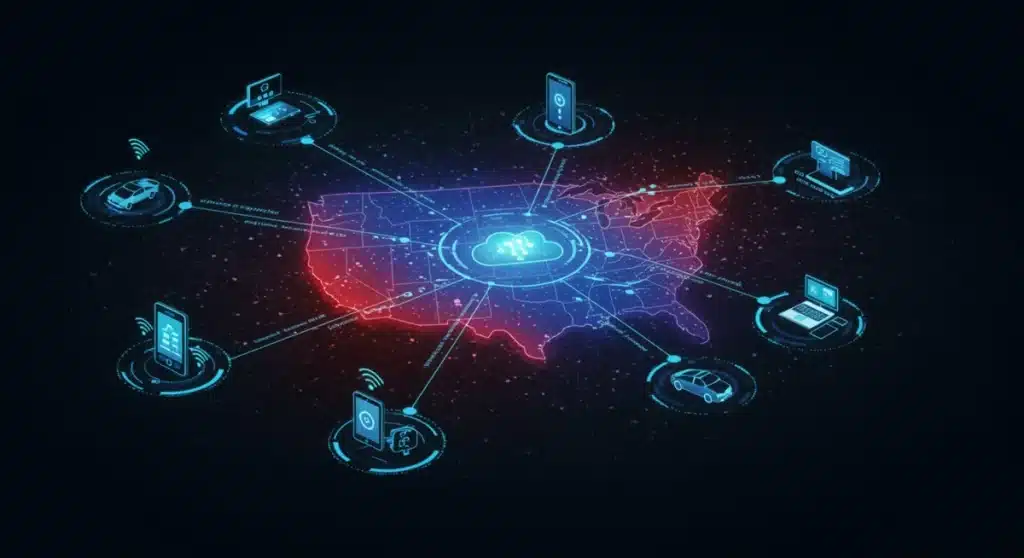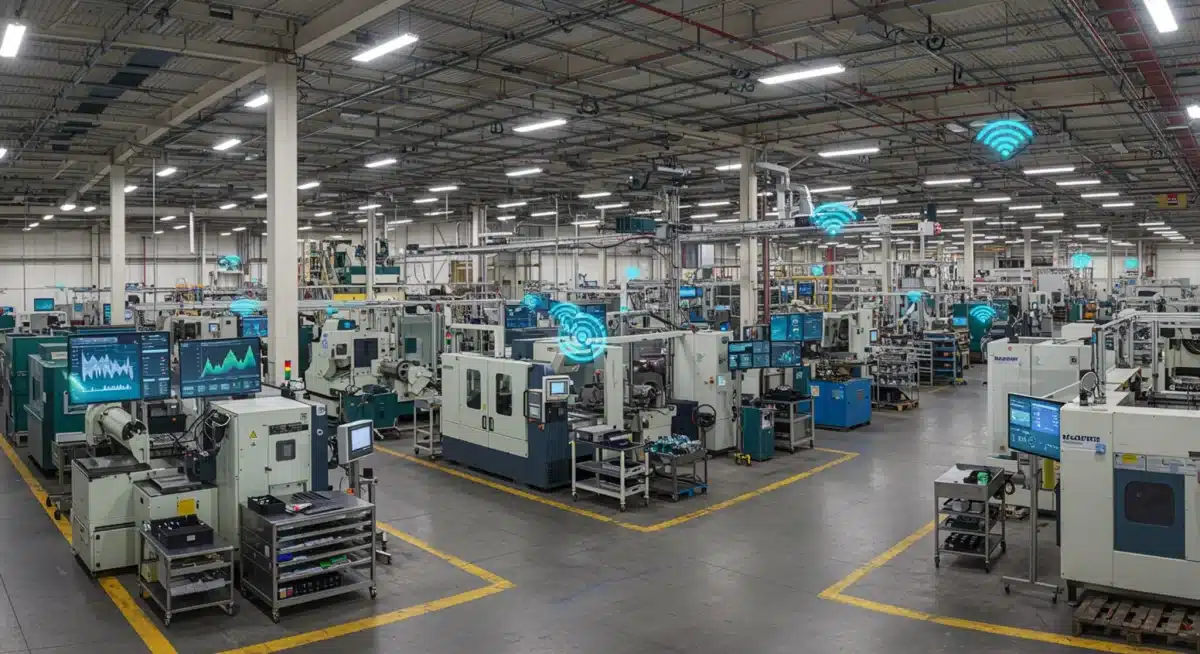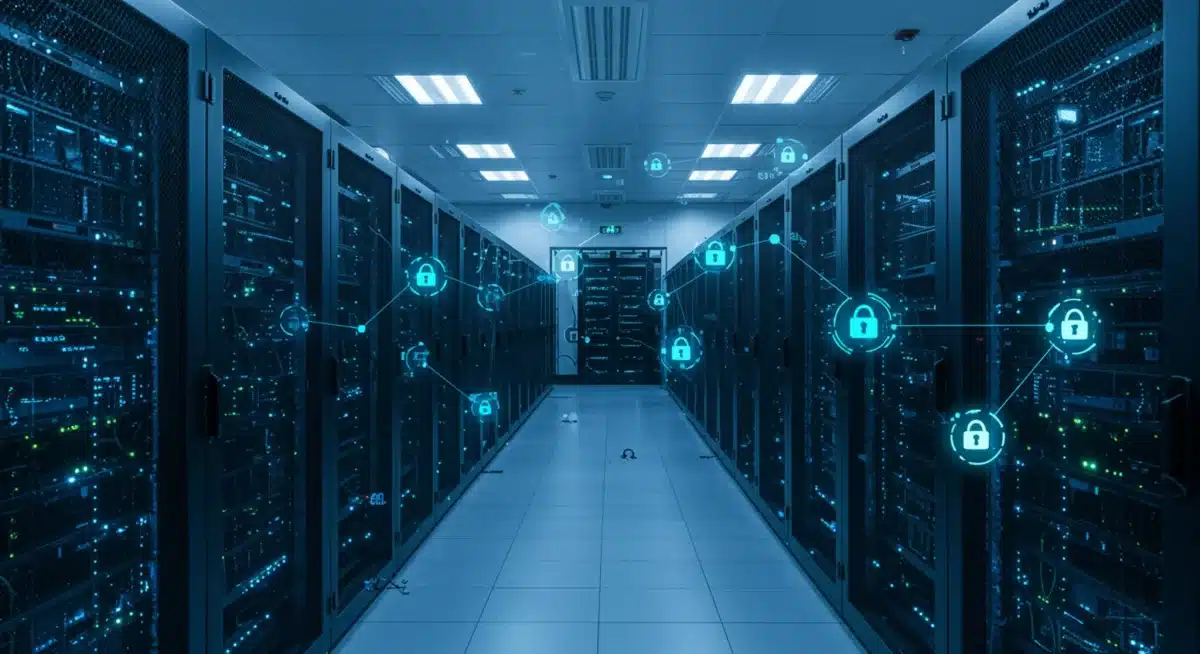Edge Computing: US Business Benefits from Decentralized Data

Edge computing empowers US businesses to decentralize data processing, bringing computation closer to the source for faster insights, reduced latency, and enhanced operational efficiency across diverse industries.
In an increasingly data-driven world, the traditional model of sending all information to a centralized cloud for processing is showing its limitations, especially for US businesses demanding real-time insights and robust security. This is where US edge computing emerges as a transformative solution, bringing data processing closer to the source of data generation. It promises a paradigm shift, enabling faster decision-making, optimizing bandwidth, and bolstering data privacy, thereby unlocking unprecedented opportunities for innovation and competitive advantage across various sectors.
Understanding the Fundamentals of Edge Computing
Edge computing represents a distributed computing paradigm that brings computation and data storage closer to the sources of data. This approach minimizes the need for data to travel long distances to centralized cloud servers, addressing critical challenges related to latency, bandwidth, and connectivity. For US businesses, understanding these fundamentals is the first step toward unlocking its immense potential.
At its core, edge computing is about decentralization. Instead of relying solely on massive, distant data centers, it leverages smaller, localized computing resources. These ‘edge’ locations can be anything from a factory floor server, a smart traffic light, a retail store’s point-of-sale system, or even a smartphone. The goal is to process data where it’s generated, extracting immediate value without delay.
The Shift from Cloud to Edge
While cloud computing revolutionized data storage and processing scalability, the proliferation of IoT devices and real-time applications exposed its inherent limitations. The sheer volume of data generated by connected devices, combined with the demand for instantaneous responses, made a purely cloud-centric model inefficient for many use cases. Edge computing complements the cloud, offloading specific tasks for localized processing while still leveraging the cloud for broader analytics and long-term storage.
- Reduced Latency: Processing data closer to the source drastically cuts down the time it takes for data to travel, be processed, and return. This is crucial for applications where milliseconds matter.
- Optimized Bandwidth: By processing and filtering data at the edge, only relevant or aggregated data needs to be sent to the cloud, significantly reducing bandwidth consumption and associated costs.
- Enhanced Reliability: Edge devices can operate and process data even when connectivity to the central cloud is intermittent or unavailable, ensuring continuous operation for critical systems.
- Improved Security: Localized processing reduces the attack surface by minimizing the amount of sensitive data transmitted over networks and stored in remote locations.
The fundamental shift towards edge computing is not about replacing the cloud, but rather about creating a more intelligent, distributed, and efficient data architecture. This hybrid approach allows US businesses to harness the best of both worlds, optimizing their IT infrastructure for the demands of modern applications and data volumes.
Boosting Operational Efficiency and Real-time Decision Making
For US businesses across manufacturing, logistics, healthcare, and retail, edge computing offers a direct path to significantly improved operational efficiency and the capability for real-time decision-making. By processing data at the source, organizations can react instantaneously to changing conditions, optimize processes, and prevent issues before they escalate.
Consider a modern manufacturing plant. Thousands of sensors on machinery generate vast amounts of data every second. Sending all this data to a central cloud for analysis introduces delays that can be costly. With edge computing, data from these sensors can be processed right on the factory floor, enabling immediate insights into machine performance, predictive maintenance needs, and quality control issues.
Applications in Diverse Industries
The impact of edge computing on efficiency is far-reaching. In logistics, smart warehouses can use edge devices to track inventory in real-time, optimize routing for autonomous forklifts, and manage supply chain bottlenecks with unprecedented agility. This leads to faster order fulfillment and reduced operational costs.
- Manufacturing: Real-time monitoring of production lines, predictive maintenance for machinery, quality control automation, and worker safety enhancements.
- Retail: Personalized customer experiences, optimized inventory management, theft prevention through real-time video analytics, and efficient point-of-sale operations.
- Healthcare: Remote patient monitoring, real-time analysis of medical sensor data for critical interventions, and secure processing of sensitive patient information at the clinic level.
- Energy: Smart grid management, real-time monitoring of infrastructure, and optimization of renewable energy sources for improved efficiency and reliability.
The ability to make decisions in milliseconds rather than seconds or minutes provides a significant competitive advantage. Businesses can respond to market changes, customer demands, and operational challenges with a speed that was previously impossible. This not only streamlines existing processes but also opens doors for innovative services and business models.
Enhancing Data Security and Privacy at the Edge
In an era where data breaches are increasingly common and privacy regulations like CCPA are stringent, enhancing data security and privacy is paramount for US businesses. Edge computing offers a compelling solution by localizing data processing and reducing the exposure of sensitive information across wide networks.
When data is processed at the edge, it often means that only aggregated, anonymized, or less sensitive data needs to be transmitted to the cloud. This significantly shrinks the attack surface. Instead of raw, sensitive data traveling across the internet to a distant data center, it can be analyzed and filtered locally, with only necessary insights or alerts being sent further up the chain.
Strategies for Secure Edge Deployments
Implementing effective security measures at the edge requires a multi-layered approach. Edge devices themselves must be secured against physical tampering and cyber threats, often through hardware-level security features and robust authentication protocols. Network security is also critical, ensuring that communications between edge devices, edge gateways, and the central cloud are encrypted and protected.
- Data Minimization: Only collect and process data absolutely necessary at the edge, reducing the volume of sensitive information.
- Encryption: Implement end-to-end encryption for all data in transit and at rest, both at the edge and when communicating with the cloud.
- Access Control: Enforce strict access controls and authentication mechanisms for all edge devices and data, ensuring only authorized personnel and systems can interact with them.
- Anomaly Detection: Utilize AI and machine learning at the edge to detect unusual patterns or potential security breaches in real-time, enabling rapid response.

Furthermore, edge computing can aid in compliance with data privacy regulations. By keeping certain types of personal or proprietary data within specific geographical boundaries or on-premises, businesses can better control where their data resides and how it is handled, simplifying compliance efforts and mitigating risks associated with cross-border data transfers.
Reducing Latency and Bandwidth Costs for Critical Applications
The twin benefits of reduced latency and lower bandwidth costs make edge computing an economically attractive and technically superior solution for many US businesses, particularly those operating critical, time-sensitive applications. The traditional cloud model, while powerful, can introduce delays that are simply unacceptable for certain use cases.
Imagine autonomous vehicles or remote surgical robots. In these scenarios, every millisecond of delay can have severe consequences. Edge computing places the processing power directly within or very close to these devices, enabling instantaneous reactions. This proximity is vital for applications demanding ultra-low latency, ensuring safety and precision.
Cost Savings Through Optimized Data Flow
Beyond performance, edge computing offers substantial cost savings. By processing raw data at the edge and only sending processed insights or filtered information to the central cloud, businesses can dramatically cut down on the amount of data transmitted over network infrastructure. This reduces bandwidth consumption, which often translates directly into lower operational expenses, especially for organizations dealing with massive data volumes.
- Autonomous Systems: Enabling real-time decision-making for self-driving cars, drones, and robotics, where immediate response is critical for safety and functionality.
- Augmented Reality (AR) / Virtual Reality (VR): Providing the low-latency processing required for immersive AR/VR experiences, crucial for training, design, and entertainment applications.
- Smart City Infrastructure: Managing traffic flow, public safety systems, and environmental monitoring with real-time data analysis without overloading central networks.
- Remote Operations: Supporting remote control of industrial equipment and critical infrastructure with minimal delay, improving safety and efficiency in hazardous environments.
The strategic deployment of edge computing infrastructure allows US businesses to optimize their data flow, ensuring that high-priority, time-sensitive data is handled with maximum efficiency, while less critical data can still leverage the scalability and storage capacity of the cloud. This intelligent allocation of resources leads to both performance gains and significant cost efficiencies.
Overcoming Challenges and Ensuring Successful Implementation
While the benefits of edge computing are clear, successful implementation for US businesses requires careful planning and a strategic approach to overcome inherent challenges. Deploying and managing a distributed infrastructure introduces complexities that differ from traditional centralized IT models. Addressing these proactively is key to maximizing the return on investment.
One primary challenge lies in the management and orchestration of numerous edge devices and applications spread across various locations. This requires robust management platforms that can monitor, update, and secure these distributed assets efficiently. Furthermore, ensuring interoperability between diverse hardware and software components from different vendors can be complex.
Key Considerations for Deployment
Businesses must also consider the physical environment at the edge. Unlike climate-controlled data centers, edge locations can be harsh, requiring ruggedized hardware that can withstand extreme temperatures, dust, and vibrations. Power supply and connectivity reliability at these remote sites are also critical factors that need to be addressed.
- Infrastructure Management: Implementing centralized platforms for monitoring, deploying, and updating edge devices and applications remotely.
- Security at Scale: Developing comprehensive security policies and tools that can be consistently applied and managed across a vast number of distributed edge nodes.
- Data Synchronization: Establishing efficient mechanisms for data synchronization between edge locations and the central cloud, ensuring data consistency and integrity.
- Skills Gap: Investing in training or hiring personnel with expertise in distributed systems, IoT, and edge-specific technologies to manage the new infrastructure.

Despite these challenges, the strategic advantages of edge computing often outweigh the complexities. By partnering with experienced technology providers, adopting standardized protocols, and investing in scalable management tools, US businesses can navigate these hurdles and build a resilient, high-performing edge infrastructure that drives innovation and growth.
The Future Landscape: Edge Computing and 5G Integration
The synergistic relationship between edge computing and 5G wireless technology is poised to redefine the future landscape of digital transformation for US businesses. While edge computing brings processing closer to the data source, 5G provides the ultra-fast, low-latency, and highly reliable connectivity necessary to unleash the full potential of edge applications.
5G’s capabilities, including its massive bandwidth and reduced latency, are perfectly aligned with the demands of edge computing. It enables a seamless and efficient flow of data between edge devices and localized processing units, as well as between edge nodes and the central cloud. This integration is critical for applications that require instantaneous communication and massive data throughput, such as autonomous systems, augmented reality, and industrial IoT.
Transformative Impact on Industries
The combination of edge computing and 5G will unlock new possibilities across various sectors. In smart cities, it will enable real-time traffic management, intelligent public safety systems, and efficient utility monitoring. For healthcare, it will facilitate advanced telemedicine, remote diagnostics, and real-time monitoring of patients with unprecedented accuracy.
- Autonomous Vehicles: 5G provides the ultra-reliable, low-latency communication vital for vehicle-to-vehicle (V2V) and vehicle-to-infrastructure (V2I) communication, processed at the edge for immediate decision-making.
- Industrial IoT (IIoT): Enables massive deployment of sensors and real-time data analysis on factory floors, driving automation, predictive maintenance, and operational optimization.
- Enhanced Customer Experiences: Powers immersive AR/VR applications in retail, entertainment, and training, delivering highly responsive and personalized interactions.
- Public Safety: Facilitates real-time video analytics from public cameras, enabling faster response times for emergency services and improved situational awareness.
As 5G networks continue to expand across the United States, the adoption of edge computing is expected to accelerate dramatically. This powerful combination will not only enhance existing business operations but also foster the creation of entirely new services and industries, positioning US businesses at the forefront of digital innovation.
Strategic Advantages for US Businesses in the Competitive Market
In today’s highly competitive global market, US businesses are constantly seeking innovative ways to gain an advantage. Edge computing offers a suite of strategic benefits that can significantly bolster their position, from fostering innovation to building more resilient and responsive operations.
One of the most compelling advantages is the ability to miniaturize and decentralize their IT infrastructure. This allows businesses to deploy computing power precisely where it is needed, whether it’s a remote oil rig, a bustling retail store, or a smart farm. This flexibility enables rapid deployment of new technologies and services, reducing time-to-market for innovative solutions.
Driving Innovation and Market Leadership
By bringing computation closer to the data source, edge computing empowers businesses to develop and deploy cutting-edge applications that were previously impractical due to latency or bandwidth constraints. This includes advanced AI and machine learning models running at the edge for real-time inference, enabling smarter automation, personalized customer experiences, and more sophisticated data analysis.
- Competitive Differentiation: Developing unique services and products that leverage real-time data processing and ultra-low latency, setting businesses apart from competitors.
- Operational Resilience: Maintaining critical operations even during network outages to the central cloud, enhancing business continuity and reliability.
- Scalability and Agility: Easily scaling computing resources at specific locations as demands grow, without overhauling an entire centralized infrastructure.
- Cost-Effectiveness: Optimizing data transmission costs and potentially reducing energy consumption by localizing processing, leading to better financial performance.
Furthermore, edge computing can facilitate stronger data governance and compliance, particularly for industries with strict regulatory requirements. By keeping certain data within specific localities, US businesses can better adhere to regional data residency laws and enhance customer trust by demonstrating a commitment to data privacy. This strategic advantage is not just about technology; it’s about building a more adaptable, efficient, and future-proof business model.
| Key Benefit | Brief Description |
|---|---|
| Reduced Latency | Enables real-time decision-making by processing data closer to its source, critical for autonomous systems. |
| Enhanced Security | Minimizes data exposure by processing sensitive information locally, reducing network transmission risks. |
| Operational Efficiency | Optimizes processes, improves predictive maintenance, and automates tasks across diverse industries. |
| Cost Savings | Reduces bandwidth usage and associated costs by filtering and processing data locally before sending to the cloud. |
Frequently Asked Questions About Edge Computing
Edge computing processes data closer to its source, minimizing latency and bandwidth usage. Cloud computing, conversely, relies on centralized data centers for processing and storage. Edge complements the cloud, handling immediate tasks locally while the cloud manages broader analytics and long-term storage.
Industries such as manufacturing, healthcare, retail, logistics, and smart cities gain significantly. They rely on real-time data for operational efficiency, predictive maintenance, remote patient monitoring, personalized customer experiences, and intelligent infrastructure management.
By processing sensitive data locally, edge computing reduces the amount of information transmitted over networks, thereby shrinking the attack surface. It also aids in compliance with data residency regulations and allows for immediate anomaly detection at the source.
5G’s ultra-fast speeds, low latency, and high reliability are crucial for unlocking edge computing’s full potential. It enables seamless data flow between edge devices and processing units, supporting demanding applications like autonomous vehicles and advanced AR/VR experiences.
Challenges include managing distributed infrastructure, ensuring consistent security across numerous devices, handling data synchronization, and addressing potential skills gaps. Careful planning, robust management platforms, and strategic partnerships are essential for successful implementation.
Conclusion
The journey towards decentralized data processing through edge computing is not merely a technological upgrade but a fundamental shift in how US businesses will operate and innovate. By embracing edge computing, companies can achieve unprecedented levels of operational efficiency, enhance data security and privacy, and significantly reduce latency and bandwidth costs. This strategic move positions them at the forefront of technological advancement, enabling real-time decision-making and fostering a new era of competitive advantage. As the digital landscape continues to evolve, the integration of edge computing, particularly with the proliferation of 5G, will be indispensable for businesses aiming to thrive in an increasingly connected and data-intensive world.





